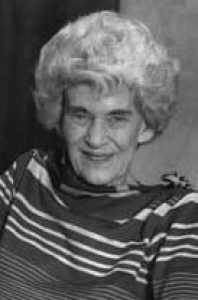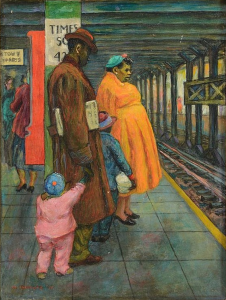
Biography
Marion Gilmore was born in 1909 in Ottumwa, IA. She was interested in both music and art, and she became accomplished in both fields. She studio the cello, first at Drake University in Des Moines, IA and later when she lived in New York. Throughout her life she played in trios and concerts, including with the Parsons College Symphony Orchestra (Fairfield, IA) and the Southeast Iowa Symphony Orchestra (Mt. Pleasant, IA).
When Gilmore finished high school in Ottumwa in 1927, she enrolled at the University of Kentucky to study art under Carol Sax. Sax was another Ottumwa native, who had worked as a camofleur in World War I. Gilmore studied next at the Child-Walker School of Art in Boston and the Rochester Athenaeum and Mechanics Institute (the forerunner of the Rochester Institute of Technology).
After moving to New York, Gilmore studied fine art at the Art Students League and illustration at the Phoenix Art Institute (later a component of the Pratt Institute). Her instructors at Phoenix in the years 1931-1932 included Norman Rockwell, Franklin Booth and Thomas Fogarty. In 1932 she spent the summer at the Stone City Art Colony in Iowa. In 1937 she worked with William Welsh at the American Academy in Chicago and then studied at the Art Institute.
Gilmore's design for a postal cachet was selected to commemorate Air Mail Week for the Ottumwa Post Office and decorated letters sent out from there in 1938. Her artwork was exhibited at the Iowa State Fair in 1938 and at the Ottumwa Art Club. 1939 found her teaching art at the Ottumwa Community Art Center with Robert Hulse, whom she was to marry in 1943.
National recognition of Gilmore's artwork came in 1939, when her design for a mural for the Corning, IA Post Office, "Band Concert," was the winning entry for Iowa. She received a commission for a second Post Office mural, "Fire Department" in Corydon, IA, which she completed in 1942.
After her marriage to Robert Hulse in 1943, Gilmore began signing her work with a gender-neutral signature "Mion Hulse." Robert worked on an exhibit at the Minneapolis Institute of Arts in 1943 and was hired as an art instruction at the University of Minnesota in Minneapolis in 1944. The couple moved to Long Island in 1952 but eventually returned to Ottumwa, where Marion died in 1984. Her work was included in the exhibit "Women Artists" at the Seiderman Gallery in Lynbrook, NY in 1995.


Critical Analysis
Gilmore's work focused typically on the themes of Social Realism. Her style was more in the direction of the Ashcan School than most other Depression Era muralists, and was distinguished by a sense of humor sometimes found lacking in the work of her contemporary Social Realist painters.
Gilmore worked as a painter, sculptor, designer and illustrator. She maintained a lifelong interest in the cello as well as her artwork and participated in varied community activities such as the Ottumwa Art Club and the Southeast Iowa Symphony.
Karal Ann Marling discusses Gilmore's Corning, IA mural in some detail. She notes that the painting was extremely well received in the community but speculates that this was not because it represented Corning so faithfully, but that it depicted an ideal that members of the community imagined it to meet. Even Gilmore admitted that the community response was a bit over the top. She had to make only a few minor changes to her original design to satisfy people who posed as sticklers for detail, even as other details that she had invented passed unnoticed.
Murals
- Corning, Iowa - Post Office: Band Concert
- Corydon, Iowa - Post Office: Volunteer Fire Department
References
- Marion (Mion) Jordan Gilmore (Hulse) (Eclectic Art & Antiques).
- Marion Gilmore (Wikipedia).
- Marion Gilmore (1909-1984) (Helicline Fine Art).
- Marion Gilmore Hulse (When Tillage Begins: The Stone City Art Colony and School).
- Marion Jordan Hulse Gilmore (askART).
- Karal Ann Marling, Wall to Wall America. University of Minnesota Press , Minneapolis, MN (1982). pp. 95-104 discuss murals of Marion Gilmore.